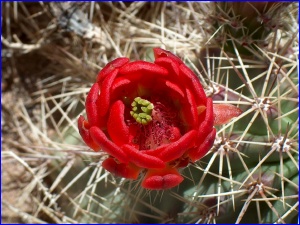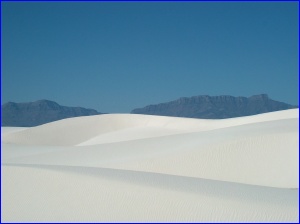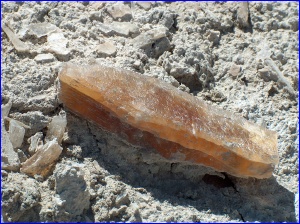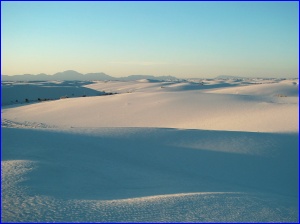

|
|
| « Previous | Next » |
Grain By Grain |
Friday, 3 April 2003 |
| written by Teresa |
Oliver Lee Memorial State Park is nestled on the alluvial fan sloping from the Sacramento Mountains down to the Tularosa Basin. Distances are deceptive with views stretching fifty miles and more, across empty desert, rich with spring foliage and surprisingly green.
 Creamy pink yucca spikes emerge from their razor sharp leaves while the deep red of claret cups are huddled close to the ground. The creosote bushes are polka dotted with small yellow flowers and the octillio tendrils wave like medusas in the wind, their pink tips and burgeoning green leaves incongruous next to their threatening needles. The desert is alive with colour and growth visibly bursting with energy. The tell tale sounds of high speed hummingbirds fill the air and in the early morning a Scott's Oriole sings his seductive spring song, clear perfectly pitched notes rippling out in a heartbreakingly beautiful melody.
Creamy pink yucca spikes emerge from their razor sharp leaves while the deep red of claret cups are huddled close to the ground. The creosote bushes are polka dotted with small yellow flowers and the octillio tendrils wave like medusas in the wind, their pink tips and burgeoning green leaves incongruous next to their threatening needles. The desert is alive with colour and growth visibly bursting with energy. The tell tale sounds of high speed hummingbirds fill the air and in the early morning a Scott's Oriole sings his seductive spring song, clear perfectly pitched notes rippling out in a heartbreakingly beautiful melody.
My first impressions of New Mexico, some weeks ago, were of a dried washed out land with little distinctive character in its topography or vegetation. I had no feeling in my heart for the place and after the dramatic colours and landscapes of Utah it seemed two-dimensional. Slowly but surely it has inveigled its way into my soul and I have come to appreciate it's distinctive beauty and wildness.
Springtime in the Tularosa Basin is synonymous with winds and from where we're camped in the state park, we can watch the dirt devils whisking the dust high into the air as they speed across the land.
 In the distance the dune fields of White Sands National Monument glare in the sun and send dust billowing up into the air eventually obscuring the surrounding mountains and dramatically reducing visibility. Every surface in the camper becomes covered with a fine layer of gritty dust and breathing too deeply is unwise.
In the distance the dune fields of White Sands National Monument glare in the sun and send dust billowing up into the air eventually obscuring the surrounding mountains and dramatically reducing visibility. Every surface in the camper becomes covered with a fine layer of gritty dust and breathing too deeply is unwise.
On calmer days, the voluptuous interlocking curves of the white sand dunes lie beneath the cerulean desert sky against the hard lines of the surrounding dark mountains in a tableau of natural dramatic contrast. It is a place of rare beauty creating a deep pleasure in the heart and a playfulness brought about by so much sand. Shadow and light create a multi layered blue-hued tapestry stretching into the distance, defining the gently rotund dunes and highlighting the distinct pencil line curve of the crests.
In the centre of the field, vegetation is confined to the inter-dune areas leaving vast curved surfaces marked only by wind ripples and occasional animal tracks. The Alkali Flats Trail goes out across this sea of sand in a loop just over four miles and normally we would view such a distance as a gentle afternoon stroll. However, having had experience of dune walking, we were not so gullible and knew what to expect. Sure enough, there were slopes of deep soft sand determined to devour all momentum, engulfing and filling our walking boots with each step and demanding more energy than a thousand foot climb. The views at the tops would have been breathtaking had it not been for the fact that we were invariably gasping by this stage.
 However, these exact same slopes offer an entirely different experience on the way down. Launching from the crest of the dune, we flew with giant steps, arms flailing in childlike freedom, laughing at the excitement of it, sand airborne at our heels creating small avalanches in our wake.
However, these exact same slopes offer an entirely different experience on the way down. Launching from the crest of the dune, we flew with giant steps, arms flailing in childlike freedom, laughing at the excitement of it, sand airborne at our heels creating small avalanches in our wake.
Once a month the park service arrange a trip to the source of the dunes, Lake Lucero. The trip crosses the missile range and so the caravan of vehicles is escorted by military police and needless to say no photographs are allowed during the journey. Forty cars and trucks set out last Saturday and after the solitude of the Alkali Flats Trail it was rather like being herded in a cattle train. In spite of the overall experience it was still worth going. "Lake" is a slight misnomer but as the ranger pointed out, any natural feature that holds water for any length of time in this dry climate is immediately called a lake, stream or river. Lake Lucero last held liquid in 1993 but still clings to its name.
Lucero is a remnant of ancient Lake Otero that at one time filled the Tularosa Basin. Gypsum rich waters washing down from the surrounding mountains were trapped here creating selenite crystals in the mud of the lake floor. These are still growing beneath the surface of Lucero while older ones lie scattered around the shores glinting in the sun and looking like shoals of grounded fish.
 It is these apparently brownish crystals of gypsum that are gradually eroded by the wind forming smaller and smaller grains that buff against each other, scratching the surfaces and creating the white appearance of the dunes. The wind also sorts out the wheat from the chaff, blowing the lighter dust particles up and away while slowly moving the sand grains into the dune field.
It is these apparently brownish crystals of gypsum that are gradually eroded by the wind forming smaller and smaller grains that buff against each other, scratching the surfaces and creating the white appearance of the dunes. The wind also sorts out the wheat from the chaff, blowing the lighter dust particles up and away while slowly moving the sand grains into the dune field.
The dry bed of the lake is covered in a thin white crust of salt crystals that gives the bizarre appearance of ice from a distance. Closer up, the surface looks completely dry but as we set out across the lake it became clear that the water table was not far from the surface and we began to leave deeper and deeper footprints as we sank into the brown mud below.
 We returned to the dunes one evening to saunter on the short nature trails and to experience the fading light and the sunset. As the light dimmed, shadows lengthened, lines momentarily became more defined, the sand took on a pink hue in contrast to the bluish shadows, eventually giving a hazy ethereal appearance absolutely perfect in its beauty, a moment of true wonder.
We returned to the dunes one evening to saunter on the short nature trails and to experience the fading light and the sunset. As the light dimmed, shadows lengthened, lines momentarily became more defined, the sand took on a pink hue in contrast to the bluish shadows, eventually giving a hazy ethereal appearance absolutely perfect in its beauty, a moment of true wonder.
| « Previous | [ Photos ] | Next » |
This log entry is available in audio format. Please click for purchase information.
Do you know someone who would enjoy this article? Click to e-mail it to them!
| Home | Log | Notes | Maps | Contact | Store |